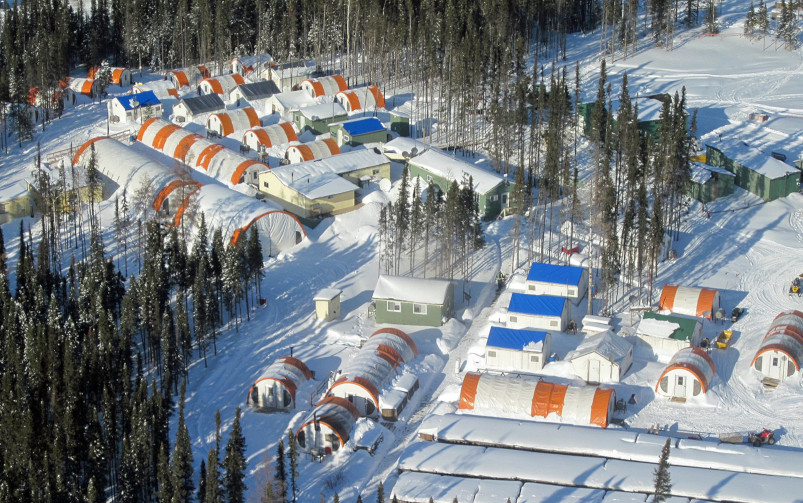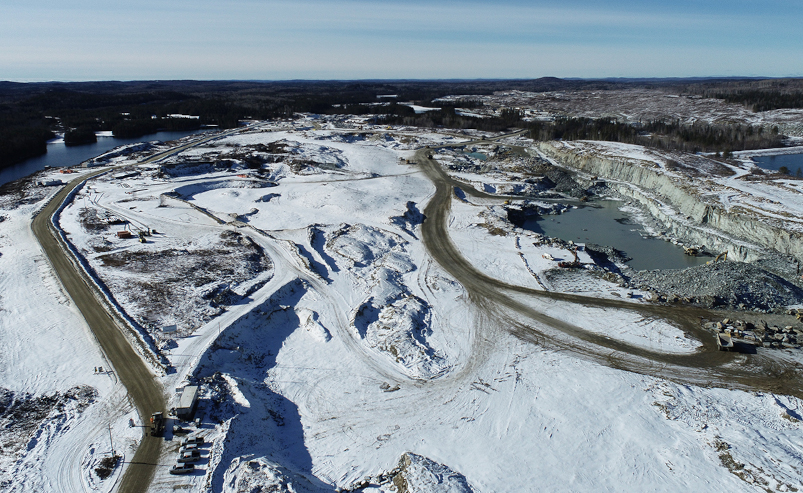On the announcement of Filo Mining's drilling results at its Filo del Sol project in Argentina, CEO Jamie Beck said he believes one especially rich drill hole "will rank as one of the best holes drilled globally this year." Courtesy of Filo Mining.
Welcome back to your weekly mining news recap, where we catch you up on some of the news you may have missed from CIM Magazine and beyond. This week’s headlines include changes to the Towards Sustainable Mining standard, a haul truck electrification challenge, and Suncor and ATCO teaming up for a hydrogen project.
Rare earth elements (REEs) have seen a surge in market interest, thanks to a combination of factors including clean-energy advances, the 2019 U.S.-China trade war and recent increased consumer interest. The field of REE mining can be quite complex due to the challenges posed by the extraction and processing of the elements, such as finding financing or establishing supply chains, but recent research and development funding in Canada and abroad has made it a more comprehensible resource for both consumers and companies.
The landscape for publicly funding mining projects in Canada can be a vast and complex one, but Alena Barreca provides a helpful primer for ways in which companies can receive government financial support for their projects. At both the federal or provincial level, companies can receive aid for employee training, research and development, business expansion and more.
The new Towards Sustainable Mining climate change protocol was released this month, and includes some significant changes to how Mining Association of Canada member companies will need to report on their responses to climate change. Most prominently, companies will provide explicit information on how they plan to adapt to and mitigate both the physical and economic effects of global climate change.
Filo Mining reported the discovery of a significant new zone of copper, gold, and silver mineralization at its Filo del Sol project in San Juan province, Argentina. Among the highlights of the discovery are one hole with a return of 163 metres at 5.43 per cent copper-equivalent, at a depth of 780 metres, and another with a return of 502 metres at 0.75 per cent copper-equivalent, at a depth of 380 metres. According to Filo, “With these latest results, the company believes that the exploration target of between 1.2 and 1.6 billion tonnes at 0.7 per cent to 1.0 per cent CuEq (in addition to the current mineral resource) will not only be realized but has obvious potential to be expanded.”
Wood Mackenzie consultancy has said that mining companies will need to invest $1.7 trillion in the next 15 years to help “supply enough copper, and other metals needed for the shift to a low-carbon world,” as reported by the Globe and Mail. Julian Kettle of Wood Mackenzie said that that investment was necessary to make a “two-degree pathway” possible – where the rise in global temperatures since pre-industrial times is limited to two degrees. Miners, however, may be wary of making heavy capital investments in order to please their shareholders and avoid generating too much supply.
Iamgold has confirmed that it will resume operations at its Westwood underground mine in southwestern Québec in the second half of 2021, Mining.com reported. The gold mine was originally halted in late October, when Iamgold had to lay off 70 per cent of its underground staff after a seismic event halted production, but the company plans to gradually restart operations in zone-by-zone stages.
Kumtor Gold Company, which is owned by Canada’s Centerra Gold, has been fined $3.1 billion by Kyrgyzstan after ruling that the Canadian company violated environmental law by placing waste rock on glaciers, Reuters reports. The company has called the charges “entirely meritless.” The decision comes just days after Kyrgyzstan passed a law allowing the state to temporarily take control of companies that pose a danger to humans or the environment. The Canadian and British embassies in Kyrgyzstan issued a joint statement expressing their concern over these developments and the potential nationalization of Kumtor, stressing that “a transparent and fair business environment is critical to recovery from the COVID-19 pandemic,” AKIpress reported.
MIRARCO Mining Innovation, a research arm of Laurentian University, announced it has received $390,350 in NSERC funding for a research project to explore discrete fracture networks to improve ground stability and reduce in underground operations. Project partners Nuclear Waste Management Organization and Iamgold are also providing further financial support for the project, which will be a five-year venture.
Suncor Energy is partnering with ATCO Ltd. to develop a clean hydrogen project near Fort Saskatchewan, Alberta, Reuters reports. The hydrogen project would be the biggest in Canada, cutting two million tonnes of greenhouse gases annually. The new facility will use the same emissions-intensive processes normally used to produce hydrogen but will capture and store the resulting carbon dioxide.
BHP, Rio Tinto, and Vale launched the Charge On Innovation Challenge, a global competition for technology innovators to develop new concepts for large-scale haul truck electrification systems, as reported by Mining.com. Current stationary charging systems are slow, and according to the companies, the industry needs more powerful fast-chargers capable of propelling a truck through its entire haul cycle. Participating vendors will receive the opportunity to showcase their technology and develop relationships with haul truck OEMS.
Companies are releasing their first quarter results, and we’ve rounded up some of the highlights.
Hudbay reported 24,553 tonnes of consolidated copper production, with an all-in sustaining cost of US$2.37 per pound of copper and a consolidated gold production of 35,500 ounces. It also reported a net loss of US$60.1 million for the quarter.
Kinross produced 558,777 gold equivalent ounces at an all-in sustaining cost of US$975 per ounce, and generated net earnings of US$149.5 million.
Trevali reported 74.8 million pounds of zinc production, with an all-in sustaining cost of US$0.99 per pound, and a net loss of US$2.5 million.
Pan American Silver produced 4.6 million ounces of silver, at an all-in sustaining cost of US$16.99 per ounce. The company also reported a net loss of US$7.6 million.
Lundin Gold produced 104,137 ounces of gold, with an all-in sustaining cost of US$830 per ounce. Its net income for Q1 was US$85.98 million.
Alexco produced 854,346 pound of lead and 100,984 ounces of silver in the first quarter, reporting a net income of US$4.2 million.
Wesdome produced 22,564 ounces of gold, with an all-in sustaining cost of US$1,182 per ounce, and a net income of $7.1 million.
That’s all for this week! The early-bird registration deadline for the 2021 Mines and the Environment Symposium closes tomorrow, May 15. You can save $100 on this upcoming virtual conference being held June 14 to 16. If you’ve got feedback, you can always reach us at editor@cim.org. If you’ve got something to add, why not join the conversation at our Facebook, Twitter or LinkedIn pages? Like your recap with a few more gifs? Check out our mining news recap stories on our Instagram.
Remember to stay safe, keep your distance and wash your hands!




